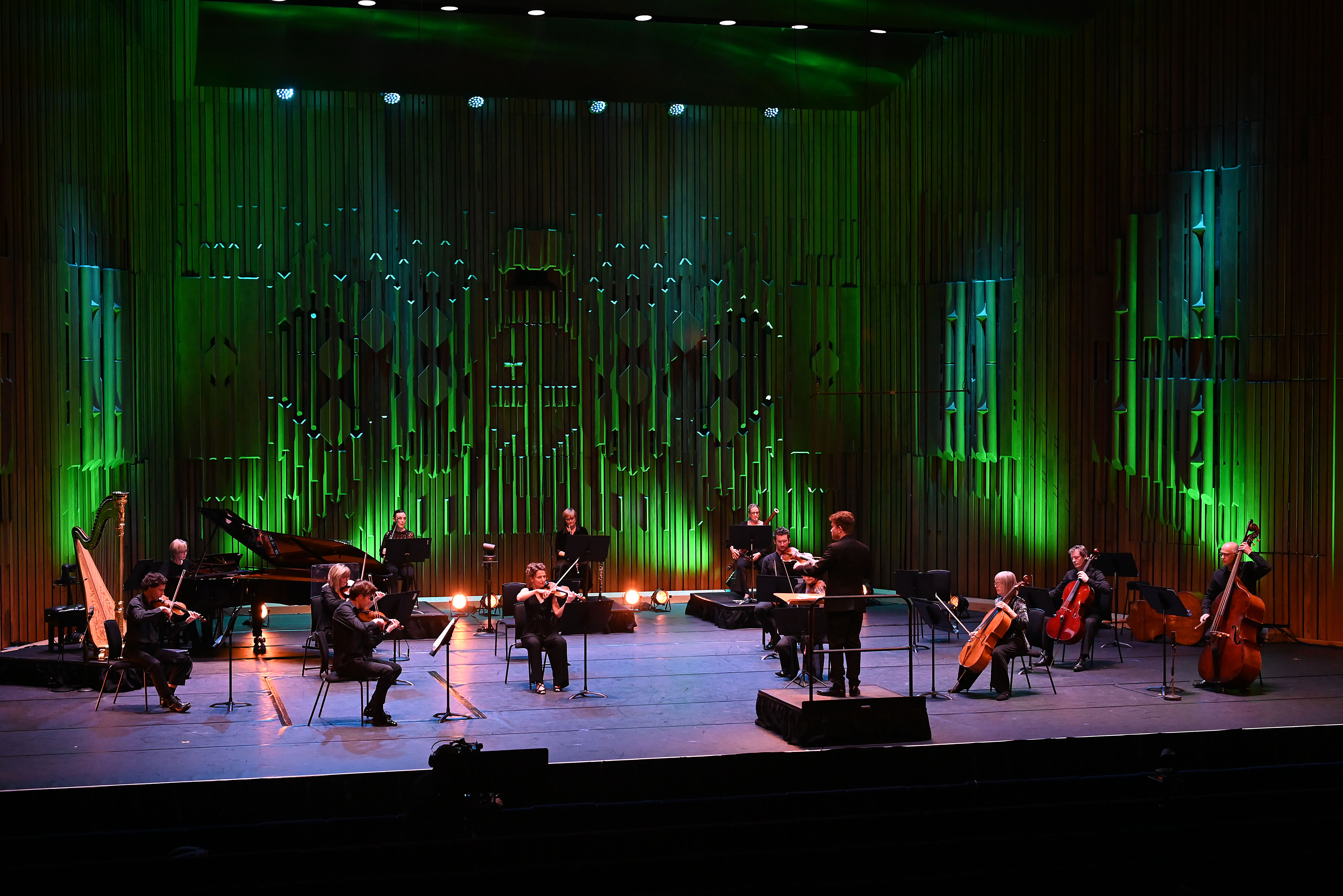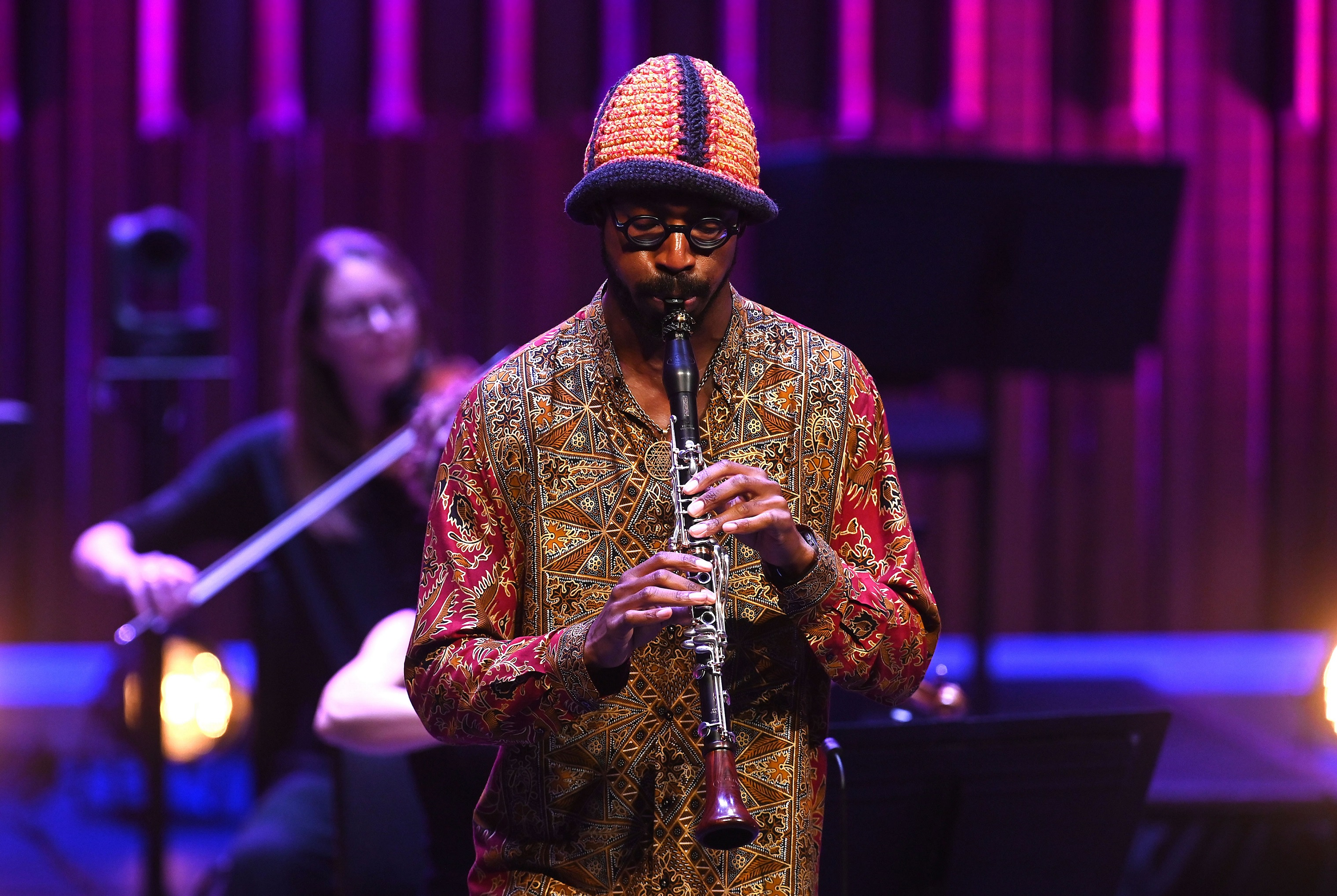Hutchings, Britten Sinfonia, Paterson, Barbican online review – saluting an American classic | reviews, news & interviews
Hutchings, Britten Sinfonia, Paterson, Barbican online review – saluting an American classic
Hutchings, Britten Sinfonia, Paterson, Barbican online review – saluting an American classic
Clarinet works by Copland and Stravinsky take centre stage at EFG London Jazz Festival
When Aaron Copland wrote his most beloved work, Appalachian Spring, in 1943/44, he gave it the unfussy working title of “Ballet for Martha” – Martha being the choreographer Martha Graham, for whom he’d written the score. It was only shortly before the premiere, long after the ink was dry on the score, that Graham appended the more alluring title, excerpted from Hart Crane’s poem "The Dance", by which the work is now known.
Scheduled as part of the Barbican’s Live from the Barbican series, as evidenced by last night’s performance by the Britten Sinfonia – in its original scoring for an ensemble of 13 instruments – what is incontrovertible is the communicative power of Copland’s music. Expertly conducted by Geoffrey Paterson, and brilliantly led by violinist Thomas Gould, the scintillating, edge-of-your-seat playing would surely convince even the most immovable naysayer that this was Copland’s finest score, vibrating as it does between a contemplative immobility and a compelling rhythmic drive (Britten Sinfonia pictured below).
One of the prime movers in the UK’s flourishing jazz scene, clarinettist, saxophonist and composer Shabaka Hutchings (Sons of Kemet, The Comet is Coming, Shabaka and the Ancestors) took to the Barbican stage to perform Igor Stravinsky’s Three Pieces for Solo Clarinet, composed in 1919. Hutchings shaped the first movement’s metrical asymmetry with great care, its liberal use of acciaccaturas and chromatic descending motif at times recalling the introduction of The Rite of Spring. Written entirely without bar lines or time signature, Hutchings made an impressive fist of the rapid-fire arpeggios and vertiginous registral leaps of the second movement, although the very opening phrase suggested that the notes weren’t entirely secure under his fingers. With its overt nods to the ‘Ragtime’ from The Soldier’s Tale, Hutchings handled the constant metrical shifts and breathlessness of the third movement with real conviction.
The six-minute clarinet improvisation which followed featured an extraordinary central section consisting of one unbroken melodic arc – with Hutchings, through the use of circular breathing, sustaining a single phrase for three minutes which at times created the impression of two-part counterpoint. The applause from the Britten Sinfonia players at its conclusion seemed entirely spontaneous (Shabaka Hutchings pictured below).
Cast in two movements connected by an extended cadenza, Hutchings and the Britten Sinfonia captured the 3/4 lilt of the opening movement, its absolute clarity of construction, and its profound melodicism to perfection, with the homogeneity of the string textures bathing the soloist in a warm glow.
Rather than recapitulating material heard in the first movement, the cadenza introduced themes which would be explored in the rhythmically charged second movement, the motoric rhythms of which sounded like the inner workings of some giant clock – with the addition of the exceptional pianist Catherine Edwards creating an even greater percussive bite. Despite some wobbly moments in the solo part during the faster passagework at the extremes of the clarinet’s register, the urgency of the pulse was undeniable, with the movement’s free rondo form referencing everything from Charleston rhythms to Brazilian folk song, all brought to a dramatic close by the soloist’s final glissando – a loving nod to Gershwin’s Rhapsody in Blue.
rating
Explore topics
Share this article
The future of Arts Journalism
You can stop theartsdesk.com closing!
We urgently need financing to survive. Our fundraising drive has thus far raised £49,000 but we need to reach £100,000 or we will be forced to close. Please contribute here: https://gofund.me/c3f6033d
And if you can forward this information to anyone who might assist, we’d be grateful.

Subscribe to theartsdesk.com
Thank you for continuing to read our work on theartsdesk.com. For unlimited access to every article in its entirety, including our archive of more than 15,000 pieces, we're asking for £5 per month or £40 per year. We feel it's a very good deal, and hope you do too.
To take a subscription now simply click here.
And if you're looking for that extra gift for a friend or family member, why not treat them to a theartsdesk.com gift subscription?
more Classical music
 Monteverdi Choir, English Baroque Soloists, Suzuki, St Martin-in-the-Fields review - the perfect temperature for Bach
A dream cantata date for Japanese maestro and local supergroup
Monteverdi Choir, English Baroque Soloists, Suzuki, St Martin-in-the-Fields review - the perfect temperature for Bach
A dream cantata date for Japanese maestro and local supergroup
 Aldeburgh Festival, Weekend 1 review - dance to the music of time
From Chekhovian opera to supernatural ballads, past passions return to life by the sea
Aldeburgh Festival, Weekend 1 review - dance to the music of time
From Chekhovian opera to supernatural ballads, past passions return to life by the sea
 Dandy, BBC Philharmonic, Storgårds, Bridgewater Hall, Manchester review - a destination attained
A powerful experience endorses Storgårds’ continued relationship with the orchestra
Dandy, BBC Philharmonic, Storgårds, Bridgewater Hall, Manchester review - a destination attained
A powerful experience endorses Storgårds’ continued relationship with the orchestra
 Hespèrion XXI, Savall, QEH review - an evening filled with laughter and light
An exhilarating exploration of innovation in 16th and 17th century repertoire
Hespèrion XXI, Savall, QEH review - an evening filled with laughter and light
An exhilarating exploration of innovation in 16th and 17th century repertoire
 theartsdesk at the Dublin International Chamber Music Festival - musical revelations, nature beyond
Artistic director Ciara Higgins’ programming ensures plenty of surprises
theartsdesk at the Dublin International Chamber Music Festival - musical revelations, nature beyond
Artistic director Ciara Higgins’ programming ensures plenty of surprises
 Müller-Schott, RSNO, Søndergård, Usher Hall, Edinburgh - spectacular Shostakovich to end the season
Brilliant orchestral results, while the cellist walks a tightrope in the Second Cello Concerto
Müller-Schott, RSNO, Søndergård, Usher Hall, Edinburgh - spectacular Shostakovich to end the season
Brilliant orchestral results, while the cellist walks a tightrope in the Second Cello Concerto
 Classical CDs: Cannons, culverts and mooching cattle
Box sets celebrating a pair of conductors, plus baroque vocal music and a beguiling bassoon anthology
Classical CDs: Cannons, culverts and mooching cattle
Box sets celebrating a pair of conductors, plus baroque vocal music and a beguiling bassoon anthology
 Marwood, Crabb, Wigmore Hall review - tangos, laments and an ascending lark
Accordion virtuoso’s brilliant arrangements showcase the possibilities of the instrument
Marwood, Crabb, Wigmore Hall review - tangos, laments and an ascending lark
Accordion virtuoso’s brilliant arrangements showcase the possibilities of the instrument
 Batiashvili, LSO, Pappano, Barbican review - French and Polish narcotics
Szymanowski’s fantasy more vague than Berlioz’s, but both light up the hall
Batiashvili, LSO, Pappano, Barbican review - French and Polish narcotics
Szymanowski’s fantasy more vague than Berlioz’s, but both light up the hall
 Owen, Manchester Camerata, Takács-Nagy, Stoller Hall, Manchester review - more Mozart made in Manchester
Another breath of fresh air in the chamber orchestra’s approach to the classics
Owen, Manchester Camerata, Takács-Nagy, Stoller Hall, Manchester review - more Mozart made in Manchester
Another breath of fresh air in the chamber orchestra’s approach to the classics
 Josefowicz, LSO, Mälkki, Barbican review - two old favourites and one new one
Julia Perry well worth her place alongside Stravinsky and Bartók
Josefowicz, LSO, Mälkki, Barbican review - two old favourites and one new one
Julia Perry well worth her place alongside Stravinsky and Bartók

Add comment